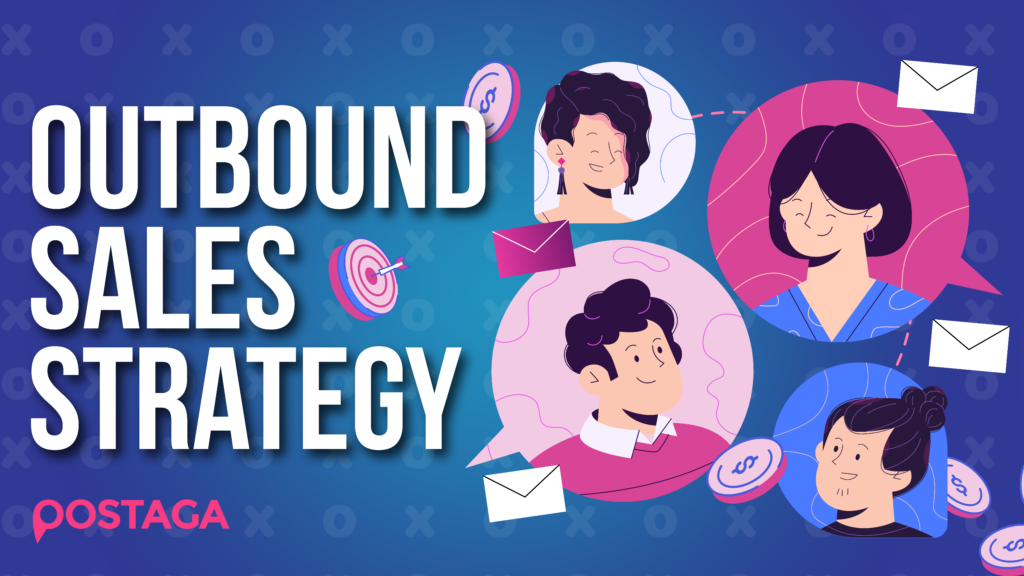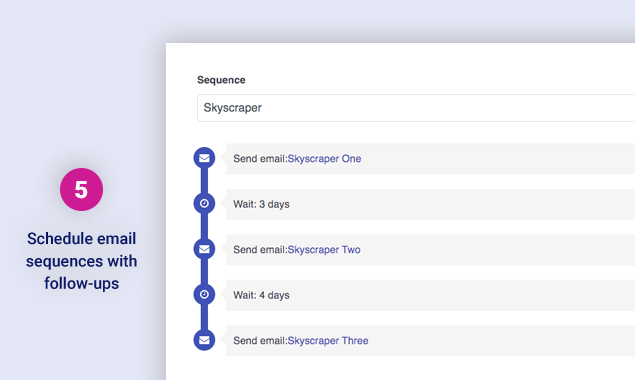
Tell me, does even hearing the words – outbound sales – make your hair stand on end?
I’m not surprised.
Let’s face it; outbound sales doesn’t really enjoy a good reputation anymore. For many sales professionals, the strategy has become practically synonymous with having to cold call and irritate prospects and aggressively force the sales message on them.
Hell, there’s even data that supposedly proves the tactic to be dead.
(Spoiler: It’s not!)
As you read this, countless sales teams turn to powerful outbound sales strategies to connect with, engage, and build relationships with potential customers (and yes, some cold call their prospects too.)
The thing is – They rarely do it the way most people think it’s done.
In this guide, you’ll learn exactly how they do it.
Specifically, we’ll discuss everything there is about building and running the best outbound sales strategy, from theory to practical advice that will help you get insane results from it too.
Sounds exciting? Then, let’s get right to it.
What outbound sales really is?
The easiest way to explain outbound sales is as a process, or strategy reps use to proactively reach out to prospects and deliver their sales pitches to them. But the goal of outbound sales isn’t just to reach out, of course. You use the strategy to initiate contacts, build new relationships, and close more deals.
Notice the word – proactively – that I used in the above definition. It’s key to understanding the true power of outbound selling.
You see, the key to outbound sales is understanding that you, as a sales rep, take an active approach to initiate new contacts and build business relationships. In other words, outbound sales is not as much about those dreaded cold calls or cold emails. These are strategies that you use (and we’ll talk about those and other such strategies shortly.)
Instead, outbound sales is about taking action and being the first one to put your hand out for the prospect to shake.
It’s you who realizes that a particular person or a company they work for would benefit from your products or services. And it is you who take the first step to communicating that to them.
(I’m sure you’ll agree – Your outlook on the strategy changes when you consider it from that point of view.)
As a result, outbound sales is directly opposite to inbound sales.
The two strategies often get confused, so let’s understand their differences better.

How is outbound sales different from inbound sales?
I sometimes hear two terms – outbound and inbound – used interchangeably. It seems like many people consider them the same thing. They’re not.
Both form a complete sales and marketing strategy, of course. But individually, inbound marketing and outbound sales are two polar opposites.
You already know what outbound sales is. You know that it’s a strategy to proactively reach out and initiate business relationships with ideal customers.
What about inbound sales and marketing, then?
While outbound sales focuses on going out and connecting with prospects and potential customers, inbound focuses on attracting people actively searching for what you sell to your company.
In a typical inbound marketing strategy, companies use content – from blog posts, videos, social media messages, and more – and position it along the entire buyer’s journey to:
- Build brand awareness
- Instill trust
- Attract potential customers to their offering
- Generate leads, etc.
Worth Noting – In inbound strategy, customers are in charge. It’s they who choose to engage with a company’s content or not. The only thing a company can do is to place that content strategically along the customer’s path with strategies like SEO, content marketing, paid ads, social media ads and posts, and more.
In outbound sales, it’s the company that actively identifies and pursues potential prospects, builds relationships, and gets those people closer to signing the deal.
Because of that, outbound sales offers some unique benefits that its inbound counterpart simply cannot match.
(By the way, I’m not saying the above to minimize the importance of inbound strategies or discourage you from using it. Far from it! However, from the sales perspective, outbound sales offer certain advantages, and I want to highlight them to you.)
3 Key advantages of doing outbound sales
- You can conduct a highly-targeted outreach. With outbound sales, you have full control over whom you reach out to. You can be as precise as you want, reach decision-makers, and increase the success of your strategy this way.
- With outbound sales strategies, you know exactly what’s going on at all times. With cold calling, you get immediate feedback from customers. With email outreach, you get data on the performance of the campaign.
- You get a chance to build strong personal relationships. In outbound sales, nothing happens in a vacuum. You either speak to someone on the phone or converse via email, after all. And so, you start developing a personal relationship almost instantly.
But how does it all work in practice?
Let’s take a look.

What does a typical outbound sales strategy look like?
A quick note before we begin – There is no one-size-fits-all outbound sales strategy. This means that every company customizes and tailors the process to its needs, its typical sales cycle, customer journey, its product, etc.
Having said that, there are certain steps that every such strategy must include, and I’ve outlined them to you below.
So, in general, an outreach sales strategy will consist of five steps:
Step 1. Identifying the target audience
It’s quite logical, isn’t it? Before you pick up the phone or start sending emails, you need to decide whom you want to reach out to and connect with. Starting without selecting the target audience will result in you and your colleagues reaching out to people almost at random.
Granted, some of these people will turn out to be qualified leads. But from experience, I can attest that these will be few and far between.
So, before anything else, you need to select the target audience. Ideally, you should also develop at least a basic ideal customer profile to further fine-tune the characteristics of the people you want to attract.
Step 2. Building a prospecting list
This is where having an ideal customer profiler comes in handy. The profile would detail exactly whom you’d like to speak with – from their industry and company down to information about the person’s job title, role, responsibilities, and so on.
You need that information to start selecting specific people to reach out to.
Now, there are many different ways to come up with a list of people you want to connect with:
- You may have a lead generation team in-house who will provide you with those people’s names and contact information
- You can ask current customers for referrals
- Hire a prospector (or scout LinkedIn Sales Navigator data yourself)
- Even buy a prospecting list, etc.
But you can also use dedicated software to help you build such a list.
For example, Postaga (disclaimer: this is our tool) allows you to input various search parameters that describe your buyer persona and retrieve a list of relevant contacts.
With this simple feature, you can build prospecting lists and launch the outreach sales strategy quickly.
(Later in this guide, I’ll also show you how Postaga can help you scale your email outreach and put it almost entirely on autopilot.)
Step 3. The outreach
This is the step where you and your colleagues begin reaching out to your prospects. You use various outbound strategies; we’ll talk about them in detail shortly and contact people on your prospecting list.
You first engage those people, initiate a sales conversation with them, qualify them, and aim to take them to the next step.
And that is…
Step 4. Engagement through sales calls or meetings
This is where you begin to, well, actually sell.
This is also the step that can drastically differ between companies. Why? Because their sales cycle and the product might require a specific approach.
For some, the goal of the outreach would be to get the prospect to agree to a product demo. Others might want to set up a meeting to discuss the person’s and their company’s needs in more detail. Some companies will want to get on the procurement lists; others will expect prospects to place an order right away, and so on.
Whatever your objective here is, it must align with your usual sales process. If your reps typically demo the product for the customer, then your goal for outbound sales should be to get as many prospects as possible to agree to that demo.
Step 5. Closing the sale
Technically, closing isn’t a part of the outbound sales process. It’s the result of you and your team going through the process successfully. However, I thought I’d include it on the list, even to show you what the final outcome of the strategy is – Another sale.
How to do outbound sales? Common outreach techniques to use
I mentioned that when outbound selling, you use various strategies to reach out to and connect with prospects. Let’s cover what these strategies are now.
In general, the two most popular techniques in outbound sales are cold calling and email outreach.
Cold calling
Cold calling is by far where outbound sales began. It may be trivia, but also worth knowing – The first mention of a strategy similar to cold calling comes from 1873.
Yes, you read it right; it’s 1873. As in the nineteenth century.
In his sales manual, John Henry Patterson, the founder of NCR Corporation, described a face-to-face canvasing prospecting technique he wanted his salespeople to use. And it very much resembles what we do when cold calling today.
Of course, Patterson’s technique didn’t involve the actual calling. At that time, Alexander Bell hasn’t even submitted the patent for the first phone yet.
But it outlined the principles we use when cold-calling prospects today.
In cold calling, you phone people you identified as potential prospects, qualify them, and move them further in the sales process.
Naturally, today, we can also support cold calling with different inbound strategies to generate leads, warm them up, and call only when those people are ready to talk to sales. As a result, our cold outreach is less well “cold” and more targeted.
Nonetheless, even calling prospects out of the blue can deliver quite a result for your outbound sales strategy.
Email outreach
Email outreach took cold calling to a whole new level.
In this strategy, instead of calling prospects, you send them an introductory email and follow-up (with email but also other channels, like social media) until you get a response.

Because of that, email outreach offers certain advantages over cold calling:
- Scale. Because you’re using email and automation, you can reach far more prospects than you would be able to reach by phone.
- Personalization. You can also easily tailor and personalize each outreach message to individual recipients, increasing their likelihood of response.
- Alignment with the person’s schedule. With email outreach, you are not interrupting a person in their day. Your prospects can open and read your emails whenever they’re free to do so. This unintrusive approach helps you increase response rates even further.
- Consistent follow-up. Finally, with email outreach, you don’t have to constantly remember to call a prospect again or check your CRM for a list of people to follow up with. The automated software (like Postaga) will send those follow-up emails automatically.
Prospecting
You know – prospecting is a greatly overlooked technique in outbound sales. Most of the time, when we talk about outreach, we consider email and phone calls. But before you even pick up the phone, you need to ensure that you have a list of prospects to reach out to. And that those people:
- Match your ideal client criteria
- At least potentially have the need for your product or service
- You have their correct contact information
That’s where prospecting comes in. In this strategy, you conduct all the necessary research, evaluate the market and the target audience, and use dedicated prospecting tools to build relevant prospecting lists.
This brings us to the next question…

What tools and software do you need to run an outbound sales strategy?
If there’s one negative thing to be said about outbound sales is that managing it can take up a lot of your time. There’s just so much to do in a typical outreach strategy – from finding the right people to reach out to, crafting outreach messages, building and managing sales cadences, monitoring results, to working with your new leads.
Luckily, there is good news too. Various tools help you automate various aspects of the outbound sales strategy and dedicate more time to your new leads.
Now, a full disclaimer – You don’t absolutely need any of the tools I’m going to show you below. You could, in theory, run your strategy with a spreadsheet and an email program.
That said, with these tools, you’re going to save countless hours and eliminate many mistakes too.
So, what are the tools and software to use in the outbound strategy?
I can group them into three categories:
#1. Sales intelligence and prospecting tools
These tools help you research your target audience, identify decision makers, and find their email and contact information.
Why you need those tools: Scouting the web and looking for the right people to reach out to would, most likely, take up far too much of your time. With sales intelligence and prospecting tools, you can input your search parameters and quickly build a robust prospecting list.
The best sales intelligence and prospecting tools:
- LinkedIn Sales Navigator
- DiscoverOrg
- Hunter.io
- Postaga – a complete cold email outreach solution with sales prospecting and CRM built-in
#2. Email outreach software
These platforms allow you to build sales follow-up cadences and send email outreach at scale.
Why you need those tools: Because, let’s face it, sending each email manually and then tracking responses and follow-ups manually would be practically impossible.
The best email outreach tools:
- Postaga – a complete email outreach solution with sales prospecting and CRM built-in.
- Prospect.io
- Outreach
#3. Online meeting scheduler
A prospect who responded to your email may want to set up a call or meeting with you. These tools allow you to create a simple booking page and let your new lead select the date and time that works for them.
Why you need those tools: Because the endless back and forth between you and the lead to set up a simple meeting just doesn’t look professional.
Best sales meeting scheduling software:
#4. CRM
A solid sales CRM will help you keep track of your outbound strategy’s results. That’s also where you’ll log your new leads data and other information about your engagement. Finally, the CRM will serve as the one source of truth about the status of your relationship with each lead.
Why you need those tools: It can be hard to remember all the details and data about each new lead.
Best CRMs for the outbound sales strategy:
Finally, here are some tips that will help you make the outbound sales strategy a smashing success
Let me close this guide with four tips. Each relates to different aspects of the strategy, and each of those tips takes that aspect to a whole new level.
So, without any further ado…
Tip #1. Develop very specific target audience criteria
It’s easy to decide that you want to reach, say, SaaS founders with your outbound strategy.
But it’s very difficult to make it a success based on such generic target audience criteria.
After all, will you reach all founders? Or would you look for people running bootstrapped companies? Or maybe your product is best suited for larger enterprises, and so you need to engage the founders of such companies instead.
Before you start your prospecting, decide on very specific criteria for those contacts. Get as detailed as possible. If possible, base those criteria on actual customers. If your best clients are people running bootstrapped businesses in the US, then start building your ideal customer profile with that.
Tip #2. Use more than a single channel to reach your prospects
I don’t know why that is, but typically, when we think of outbound sales, we think of just one strategy.
It’s either cold calling or email outreach.
But what if you used both? And what if you added social media to the mix as well?
Before you say anything – No, the result wouldn’t be chaos but a far greater opportunity to actually reach a prospect.
You see, each of these channels is already powerful on its own. The phone lets you reach a person directly and have an open conversation with them. Email is less intrusive. Plus, you can send far more emails than you could make calls.
But there is no guarantee that you’ll reach all your prospects if you focus on just one of those channels. Not all of them will want to talk to you on the phone. Similarly, your emails might get buried in those people’s inboxes.
However, if you combine those channels and include both phone calls and emails in your sales cadence, you increase the chances of your outreach connecting you with the prospect.
Tip #3. Use market segmentation to further increase the effectiveness of your outreach messages
Even if you’ve defined narrow audience criteria, you might still end up with a broad target market. Moreover, people on your prospecting list might differ in many other ways.
This may make it difficult to write a universal sales pitch to engage them.
Segmentation allows you to further narrow your target market by breaking it into smaller chunks based on specific criteria.
You can then write custom outreach messages for each segment, ensuring that what you tell prospects will resonate with them.
Tip #4. Never delete prospects off the list
There is no point in sugar-coating this: Most people on your prospecting list will not engage with your outreach. Even if you keep following up for a long time, many will remain cold about your message.
But that doesn’t mean that those prospects couldn’t engage with you sometime in the future.
So, don’t delete your prospecting lists once the campaign is over. Move those people who haven’t responded into a long-term follow-up list.
Reach out to them after a couple of months or even longer. You never know; they might respond to your message then.
And that’s it…
Now you know everything there is about outbound sales. You know what it is and what a typical outbound sales strategy looks like. You also know what tools to use and how to make your strategy a success.
All that’s left is to start researching the target audience and implementing this advice in practice.
Good luck!
Free 14-Day Trial
Start building relationships now with your fully-featured 14-day trial!
How We Compare
Terms | Done-For-You Terms | Privacy | Write For Us | Press
© 2025 Postaga. All Rights Reserved. Made with 
